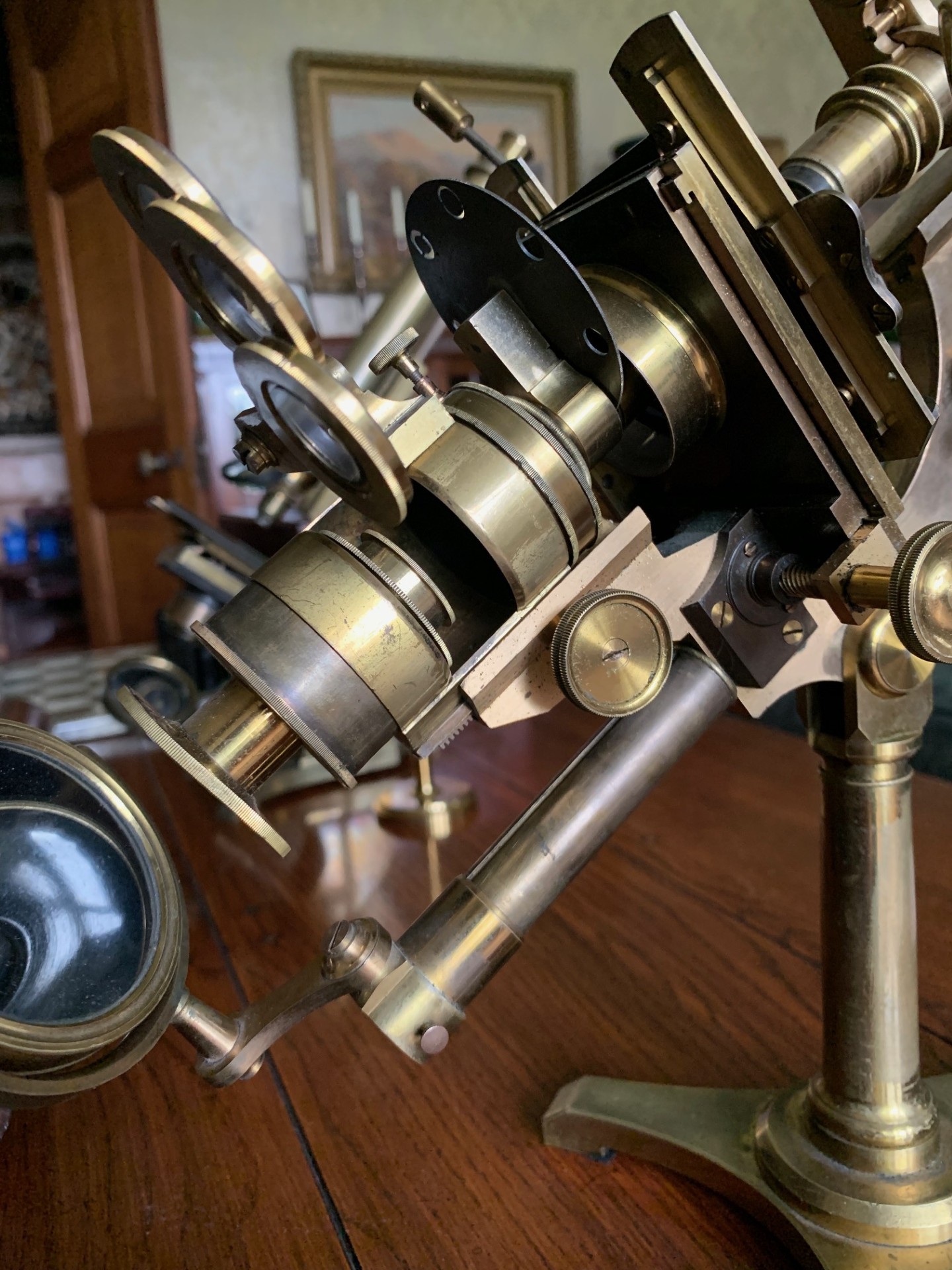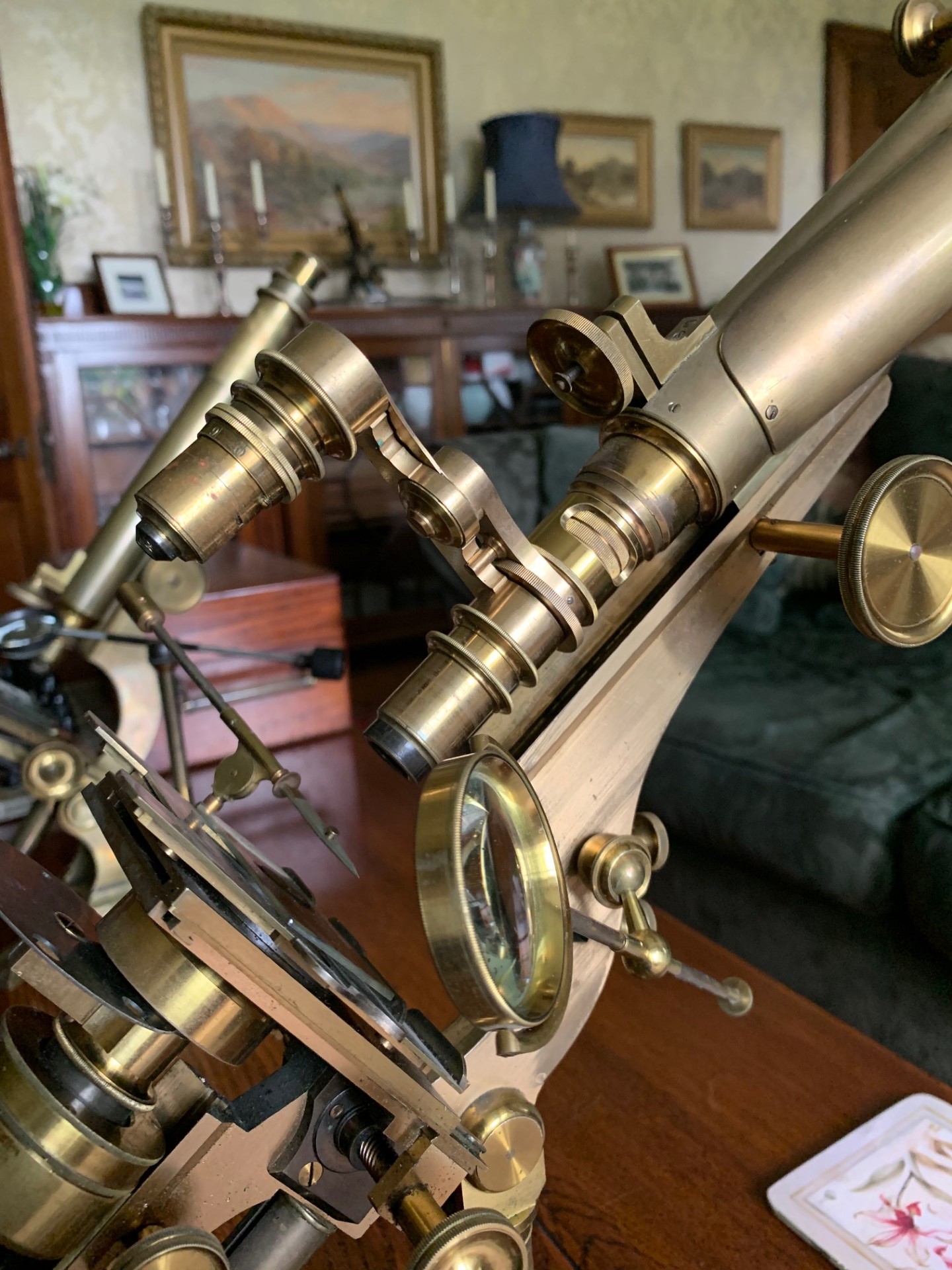SOLD – Smith & Beck Best No. 1 Single-Pillar Wenham Binocular Brass Microscope c1857, Cased
Sold
Collectable example of a Smith & Beck Best No. 1 single-pillar design with Wenham binocular feature, extensive accessories and polarising hardware - dates to the mid Victorian era and was sold in February 1857. Comes with a host of useful accessories, lovely hardwood storage case and good selection of optics.
Dimensions
20 inches
Circa
1857
Maker
Smith & Beck, London
Country of manufacture
UK and Ireland
Description
Offered for Sale is a lovely cased example of an early Smith & Beck Best No. 1 Wenham binocular with extensive set of accessories and lenses.
This listing is for a collectable early example of a Smith & Beck Best No. 1 Wenham binocular brass microscope with single pillar design. It’s a really imposing instrument standing over 20 inches high when the draw-tubes and coarse focus are racked out. This example dates to February 1857 based on its serial number 1085 which is engraved on the rear of the tripod stand and I have also had sight of the Smith & Beck sales records (delivery book entry shown in listing photos). Note: some of the accessories and components may have been added at a later date.
Background to Smith & Beck:
The firm Smith & Beck was originally established in London, by Richard Beck (1827 – 1866) in association with James Smith (1800 – 1873), and later to be joined by his brother Joseph Beck. Richard and Joseph Beck were nephews of Joseph Jackson Lister, who was a respected British optician and physicist who experimented with achromatic lenses and perfected an optical microscope. In commissioning the manufacture of his improved microscope, Lister worked with James Smith, an employee of the instrument-making firm of William Tulley, to create the stand. James Smith went on to establish his own optical instruments workshop in 1837. Through this relationship, Lister arranged for his nephew, Richard Beck to be an apprentice under Smith in 1843. In 1847, James Smith entered into partnership with Richard Beck, and the company was re-named Smith & Beck. In 1857, the company was renamed to Smith, Beck and Beck, as Richard Beck’s brother Joseph Beck joined the company. James Smith retired in 1865 and the company became R & J Beck and this name lasted until well into the latter part of the twentieth century.
So in summary, the trading name Smith & Beck was only active from 1847 to around 1857 and this example of a Best No. 1 single pillar stand number 1085 was most probably manufactured towards the end of that period and in fact as the delivery book attests was delivered around the time that the firm re-named and of course it still bears Smith & Beck inscriptions. This isn’t surprising as manufacture of such a complex instrument would take many months in consultation with the customer, whose requirements may also have evolved as the manufacture progressed leading to extended production timescales. We also know from the delivery book records that the surname of the first owner of the instrument was McTavish.
Turning to the technical details, the instrument stands on a tripod foot with single pillar leading to the main pivot joint – a nice feature is that the main instrument rotates through a full 360 degrees – giving the advantage that the heavy instrument can be adjusted for position without having to be lifted. There’s an elegant elongated upper limb of the Lister type giving a good range of coarse focus travel, allowing low power objectives of up to 3 inches to be used. The instrument tilts for inclined viewing and holds in position throughout the usable range of inclination. The upper limb also has two recesses for fitting accessories each being equipped with a knurled screw for retaining the accessory in position. Coarse focus is via the older-style straight-cut rack and pinion with smooth action and the main tube holding in position as it should on adjustment. Fine focus is controlled via a separate brass thumb-wheel at the front of the main tube, which operates a vernier screw acting on the nose-piece only and also works well.
With its optics, this instrument is the Wenham binocular type with the light-splitting Wenham prism in clean condition in its shoe carrier. The instrument can as an alternative be used in monocular configuration and there’s a separate graduated draw-tube in the case that replaces the binocular draw-tubes for conversion to monocular function for higher-powered monocular work. In binocular mode there’s a thumb-wheel controlled double rack & pinion system that adjusts inter-ocular separation, with smooth action.
There’s also a good selection of top-hat eyepiece pairs supplied with the instrument, as under:
– 5x magnification
– 8x magnification
– 10x magnification
(all eyepieces appear to be original)
There are also some appropriate objective lenses in brass, some of which have adjustment for cover glass thickness, together with an older-style double turret, which rotates freely with a positive feel as the objectives align with the optical axis:
– 3/2 inches – about 4x magnification by Smith & Beck
– 2/3rds inch – 10x magnification by Smith & Beck
– 4/10th inches – about 15x magnification Smith & Beck
– 1/4 inch – 25x magnification by Smith & Beck
– 1/8th inch about 50x magnification by Smith & Beck
– 1/10th inch – 80x magnification – R&J Beck – requires oil immersion
(all objectives have correct brass canisters)
(for demonstration purposes the optics are shown with a nicol prism nose-piece analyser fitted above the objective)
(the fit for the objectives is RMS)
Overall therefore, the magnification available ranges from about 20x with the lowest power lens combination, up to around 800x with the highest power combination and with the benefit of good illumination and use of oil immersion techniques.
The fully mechanical rectangular brass stage is well engineered and a delight to use with nice smooth action. It’s got twin thumb-wheel x/y adjusters on the right hand side of the stage and a single on the left, with no slippage on inclination. It’s fitted with a top plate that can move independently of the mechanical controls and also has a specimen holder for holding slides steady during inclined viewing and when the axes are being moved around. The freely running x/y controls also offering good accurate control of specimen positioning, which is a real advantage for higher magnification work. The stage top plate is removable, rotates and will complete a full 360 degree rotation. The stage is shown fitted for demonstration purposes with forceps and a bull’s-eye condenser.
Turning to the complex sub-stage, we have a top-mount achromatic condenser in a brass ring-mount with centering controls comprising brass thumb-screws – note the optical parts of the condenser can be adjusted/removed for use with lower-power objectives. There is a height adjustable rack and pinion system and a multi-position complex wheel-of-stops with 6 apertures and two dark-field stops. There’s a single-sided brass thumb-wheel for coarse adjustment of the condenser height. There’s also three swing-out filter holders fitted with rotatable selenites and a nicol prism polariser fitted with a top-mounted compensation plate. Lighting is via a plano-concave mirror in a brass carrier on a height and swing adjustable brass support arm and gimbal, with period silvering that’s in very good period condition to both sides. The mirror has a hairline blemish to the plano side but still perfectly functional.
There are some very useful period accessories supplied with this instrument as below:
– live box in brass – for viewing liquid specimens such as pond water
– sub-stage polariser and nose-piece analyser (note – nicol prism missing in analyser so fitted with replacement polaroid film)
– set of 3 rotating sub-stage selenites (note – some de-lamination)
– set of stage forceps
– pair of hand forceps
– small scredriver
– monocular graduated draw-tube
– dark-field condenser
– lieberkuhn reflector for fitting to the 4/10th inch objective
– lieberkuhn stage tool that fits into the limb
– bull’s-eye condenser that fits into the limb
– parallel plate compressor for slide preparation
– sub-stage darkwell holder with three darkwells of different sizes
– sub-stage reflector/illuminator for oblique lighting
– an erector lens that screws into the end of the draw-tube
– various other accessories
The instrument and its controls have been very gently dusted, lightly lubricated and operate smoothly with age-appropriate signs of wear as one would expect for a quality instrument of this age. This imposing instrument presents amazingly well with lovely gleaming brass-work that catches the light beautifully. There are some dull areas to the brass which may not have had original factory lacquer, other areas with signs of tarnishing, lacquer loss and spotting here and there which is what you’d expect for an instrument of this age that’s been both used and well looked after throughout its life. Overall, it’s in pretty good functional and cosmetic shape for its age. This example is essentially a rare collectible Smith & Beck Best No. 1 single-pillar in the right condition for a collector and it’ll make a great usable instrument and also a stunning display piece. It presents rather well when dressed with accessories and some of the listing photos show the instrument set up as a display piece and I’m certain it will also look the part in a library or home office setting, especially when set up with an appropriate antique slide.
There’s a substantial fitted hardwood storage case with this example shown in the listing photos. The case is able to accommodate the entire instrument with its full retinue of accessories, which is an amazing feat in its own right.
Owing to the weight and delicacy of this antique microscope and its host of accessories, it will be partially dismantled, very well wrapped for shipping and dispatched by insured courier upon receipt of cleared funds. Yes, it’s very expensive, but it will be quite difficult to find another such example with a good selection of period accessories and its correct case. So, if there’s a gap in your collection for a Smith & Beck Best No. 1 Wenham binocular, or if this type of instrument is something of a grail piece, as it was with me for a long time, then maybe you’ve finally found one.
Ask the Dealer
Dealer information
 Arcboutant Scientific
Arcboutant Scientific
Howard Nutton based in Glasgow Scotland with a background in Natural Science along with previous career in risk management. I obtained my first antique microscope in 1988 - it was a Watson Edinburgh model H serial number 23604 - dating it to 1918. Since that time I've owned and restored hundreds of similar instruments. As Arcboutant Scientific now also making available personally curated fine examples, principally of antique microscopes and associated scientific equipment by quality English and Continental makers, to collectors world-wide.










































